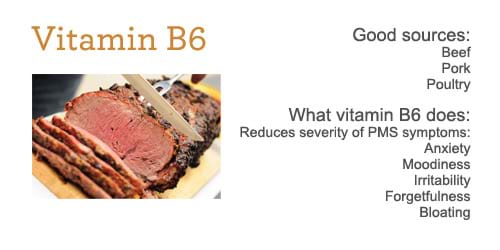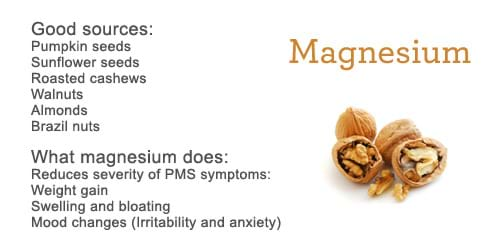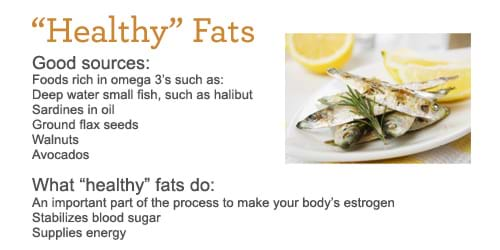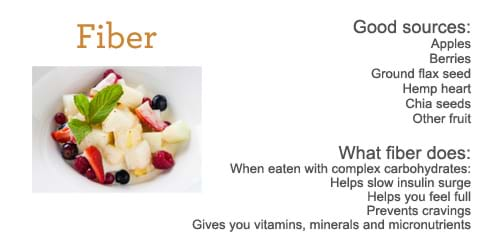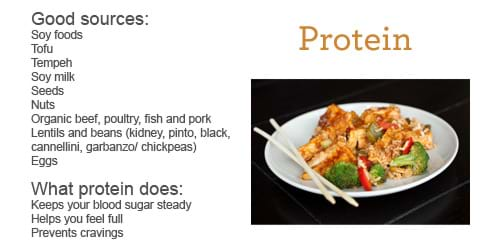If your PMS grocery shopping list consists of chocolate bars, tortilla chips, and triple chunk ice cream, we’ve got some helpful news for you.With a few simple changes to the food you eat, you can reduce, and even prevent, PMS symptoms.
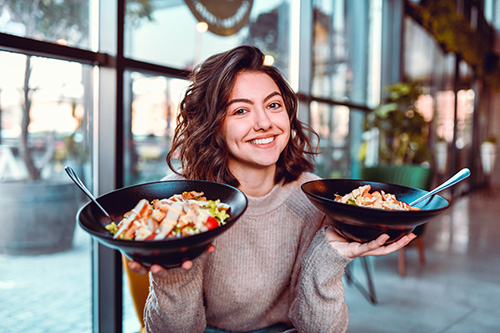
In fact, eating is one of the simplest and most effective methods for controlling monthly irritability, bloating, anxiety, and cramps — along with many more of the most common PMS symptoms.
Food choices can be a powerful source of relief for PMS symptoms. By understanding why what you eat matters, knowing which foods are PMS-friendly, and following our general guidelines, you can create big results. We know they’ll work for you too!
Why what you eat matters — a lot
The food you eat has a direct impact on how you feel because of your diet’s influence on key factors that affect both the severity and frequency of PMS symptoms:
| Factor | How Food Can Cause Trouble… | How the Right Food Can Help… |
|---|---|---|
| Balance between estrogen and progesterone | Fuels fluctuations and spikes in estrogen and progesterone ratios, which worsen PMS symptoms. | Decreases the imbalances caused by fluctuations in estrogen and progesterone ratios and helps prevent PMS symptoms. |
| Blood sugar | Creates a “sugar rush” followed by a crash, which increases symptoms. | Stabilizes blood sugar levels to prevent symptoms. |
| Necessary nutrient status | Leads to gaps in nutrition that can produce PMS symptoms. | Provides the support our bodies need during ovulation and menstruation, which helps control PMS symptoms. |
Making good nutritional choices is important for women who are more likely to suffer from PMS — especially those in their late 20s through early 40s. And it has long-lasting effects because women who experience PMS also have a higher risk for more dramatic perimenopause and menopause symptoms later in life. That’s why so many women find it helpful to make diet changes before they enter the midlife transition.
Try our PMS Relief Packge, which includes a flexible eating plan.
Getting started: Tips to incorporate the right foods into your diet
Over the years, Women’s Health Network customers have shared their secrets for improving their diets and reducing their PMS symptoms:
 |
If you don’t like standard breakfast foods…
Non-traditional choices are good for breakfast too. Try a turkey burger, soup, leftover chicken and vegetables, or half of a healthy, whole grain sandwich. With a good breakfast, the rest of the day often falls into place. |
 |
If you’re addicted to caffeine…
Get started by reducing your caffeine intake slowly. Many women find success cutting down a ½ cup at a time (for coffee drinkers, mix regular with decaf; for soda and cola drinkers, gradually replace with flavored and unsweetened water, plain for fizzy). There are a wide variety of teas available too — even chocolate! |
 |
If you can’t imagine not having dessert…
Continue to enjoy sweet treats – such as fruit with cinnamon, fruit salad or your favorite treat recipes made with maple syrup or Stevia, rather than refined sugar. A small square of dark chocolate is a good treat too. Look for 70 percent cocoa content or higher. |
 |
If you like to eat out…
You can still go to restaurants! Try having a big salad with lots of protein. Japanese food gives you lots of good options – sashimi, seaweed, natto and brown rice, along with a variety of super-tasty vegetables. Indian food has wonderful choices including curry dishes, lots of vegetables, and protein-packed lentils. |
 |
If you’re a snacker…
Nuts and seeds are great choices and there are so many options — pumpkin seeds, sesame seeds, walnuts, almonds and Brazil nuts! |
 |
If you don’t like vegetables…
Be sneaky and disguise your veggies. Include a handful of spinach in a fruit smoothie and you’ll never notice. Experiment by preparing vegetables with new herbs and spices, such as ginger and turmeric. Coconut milk and curries can also give you a flavor boost. |
 |
If you’re a vegan…
Make an extra effort to get protein at every meal, and include nuts and seeds for healthy fats, and lentils for protein. |
What are some overall “good eating” guidelines for PMS?
- Eat a variety of foods, including healthy fats, complex carbohydrates/fiber and protein at every meal (and snack!).
- Eat three balanced meals and two snacks a day to stop cravings and keep your metabolism steady.
- Avoid white sugar, refined carbohydrates, salt, cocktails, non-organic dairy, caffeine, and processed foods of all kinds. (See better food choices in the slideshow above.)
- Ensure you’re getting the right amount of each key nutrient every day by taking a high-quality multi vitamin that includes calcium, magnesium, vitamin E, and vitamin B6.
- Be aware that pre-packaged foods that say “organic” may still be very high in sodium or gluten. Become a label reader!
Small steps = substantial results
When it comes to making PMS-friendly nutritional choices — you have a lot of options! We encourage you to remember not to overwhelm yourself with everything that you “could” do. It’s okay to start slowly and make changes that work for you and your lifestyle right now. We also encourage you to relax and make eating a pleasurable experience by choosing foods you truly enjoy. As often as possible, take time to sit down and savor the experience of eating.
To get started, why not think about one change you would like to make.
You have the power to make next month a whole different experience and it’s right there on your plate!








